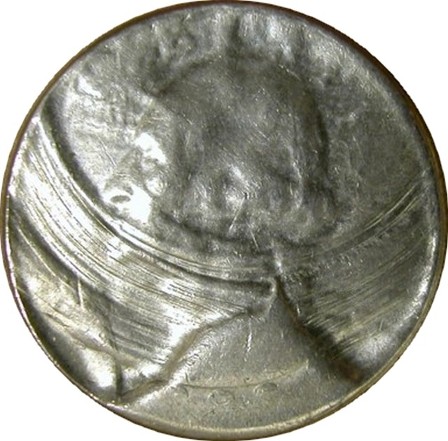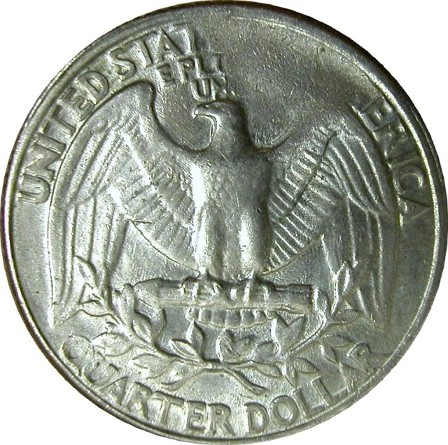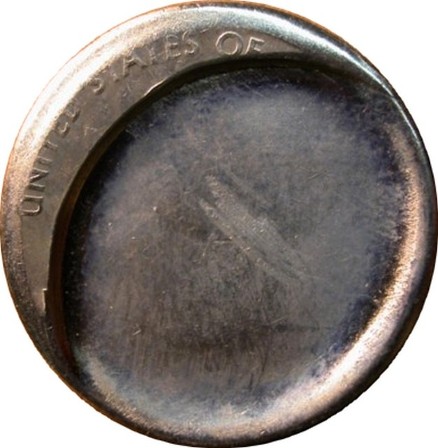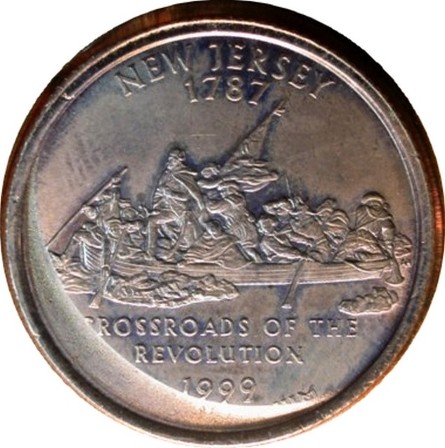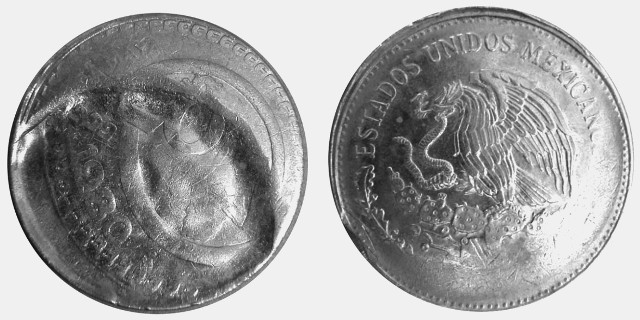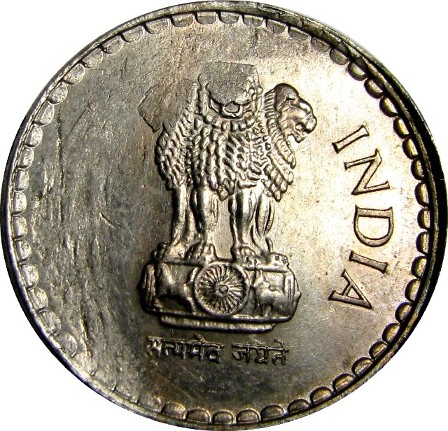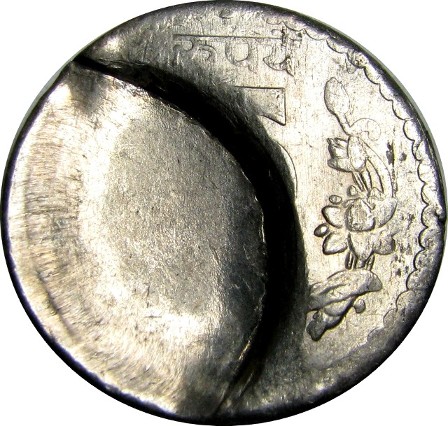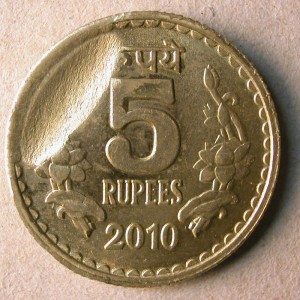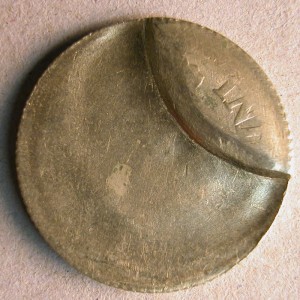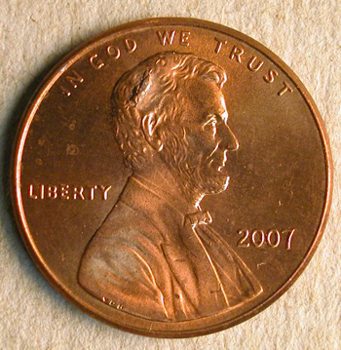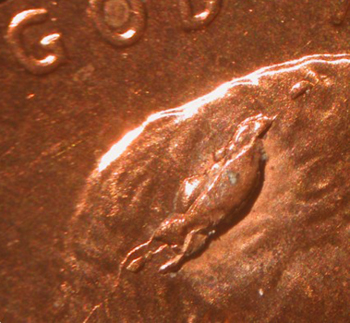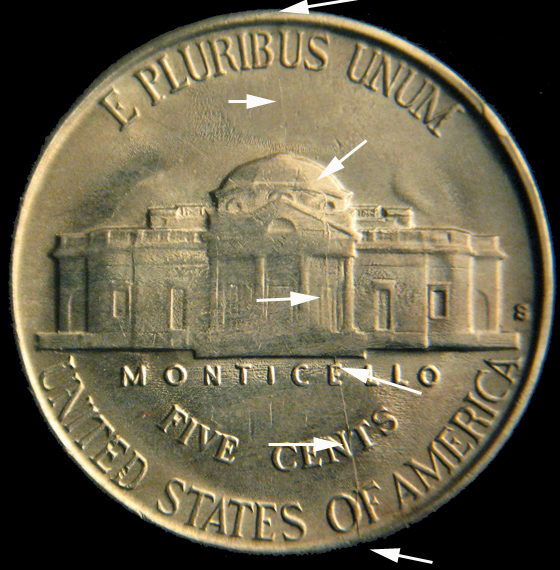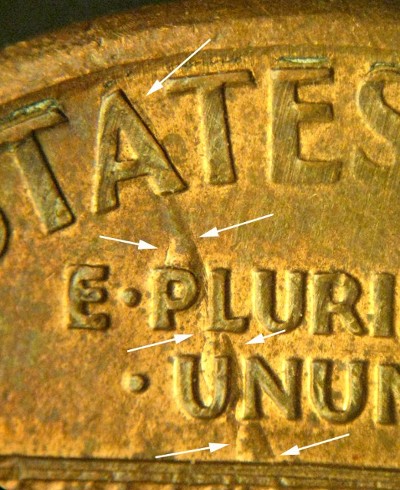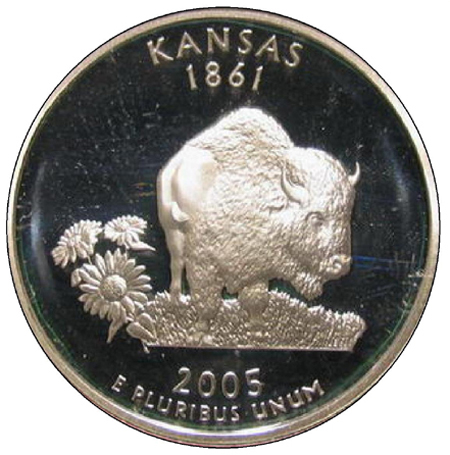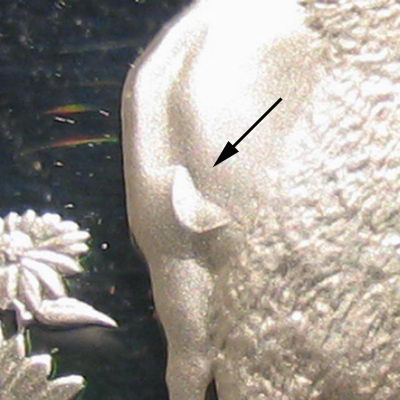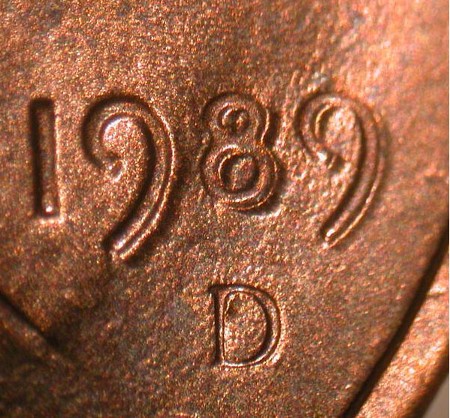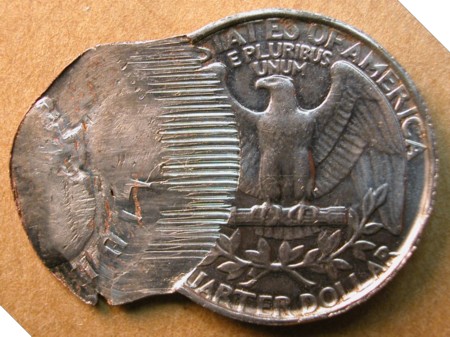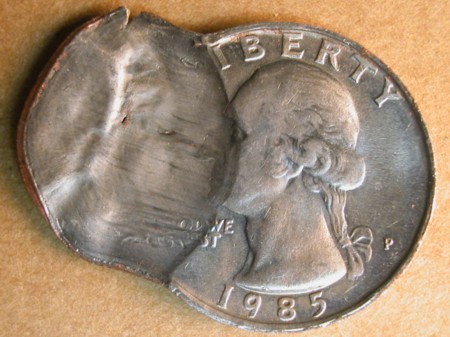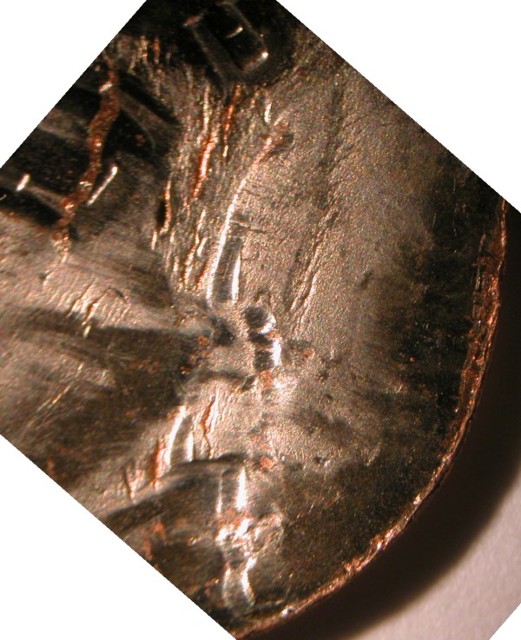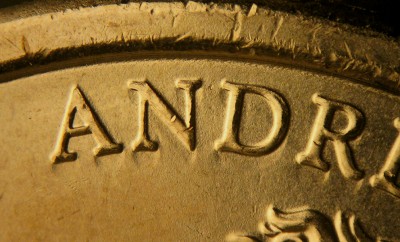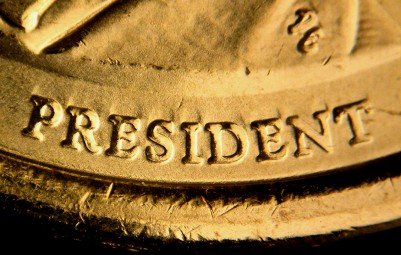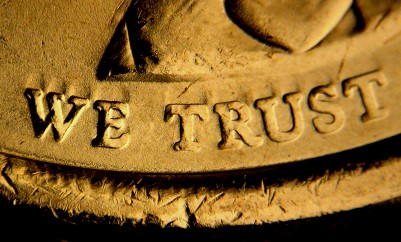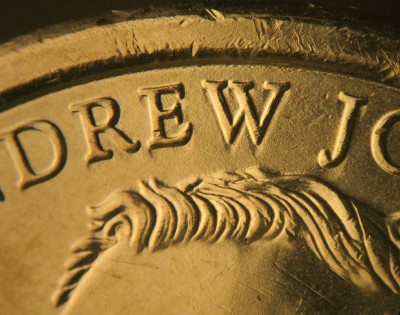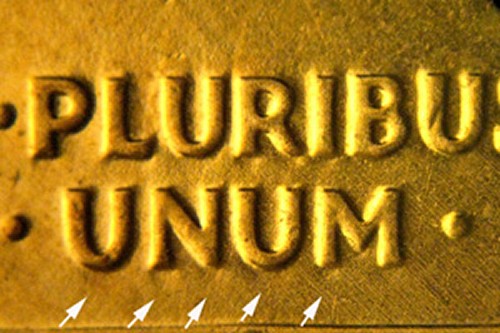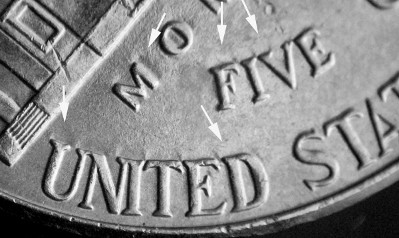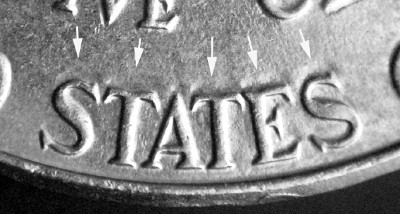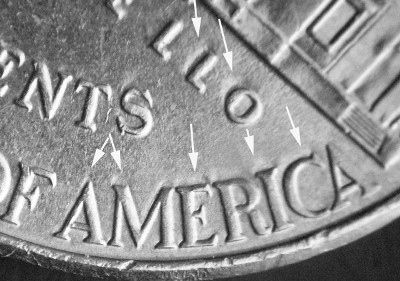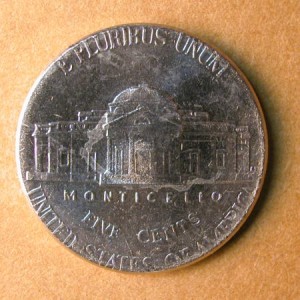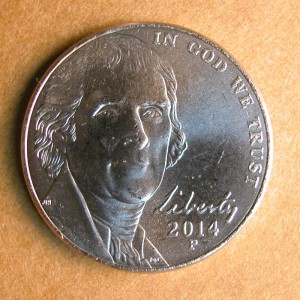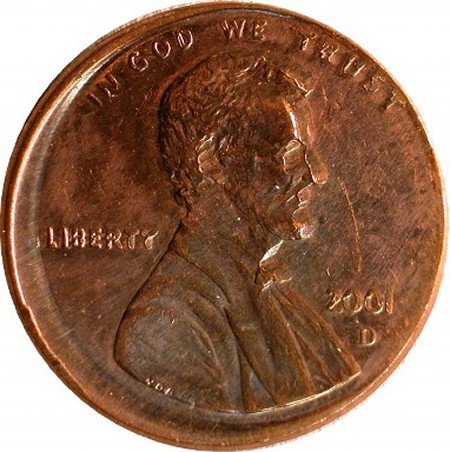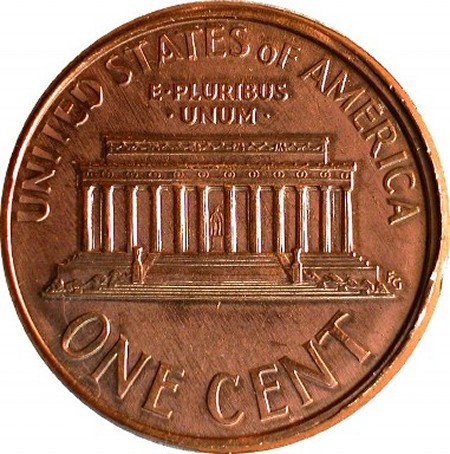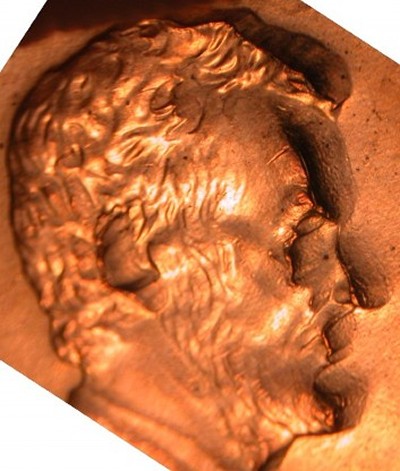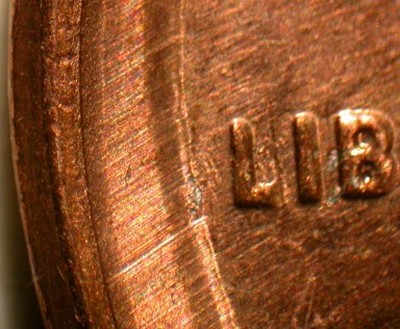Compiled by Mike Diamond
This checklist is my attempt to compile a comprehensive listing of all known variety and error types, subtypes, and associated effects. It is updated periodically to reflect the current state of knowledge.
While the traditional planchet-die-striking method of classification hasn’t been completely abandoned, it has been absorbed into a much more detailed and precise taxonomy. This is intended to reflect the numerous steps (and missteps) in the minting process that generate the great diversity of anomalies presented here.
Many of the categories will be familiar to veteran collectors. Others will perhaps be dimly recalled, while others will be unfamiliar. Many of the more obscure error types have been treated in detail in articles published in Errorscope. These articles are referenced next to the appropriate entry (“ES”). Other treatments can be found in Coin World (“CW”).
I have tried to restrict this checklist to basic error/variety types and subtypes. Combination errors have been kept to a minimum. Had I attempted to incorporate all conceivable two-error combinations, this would have generated almost half a million entries. That would have been both unwieldy and unnecessary.
ES=Errorscope
CW=Coin World
Part I. Die Subtypes:
Patterns and Prototypes (accidental release)
-
- 1916 Winged Liberty (“Mercury”) dime patterns
- 1971-S Eisenhower dollar prototype
- 2000-P Sacagawea “Cheerios” dollar
Mid-year design modifications
-
- 1796 to 1799; 13, 15 and 16 stars on the U. S. dime, half dollar and dollar
- 1853 Seated Liberty dimes and half-dimes, with and without arrows
- 1867 Shield nickel with and without rays on the reverse
- 1883 Liberty Head nickel; with and without the word CENTS
- 1909 Lincoln cent; with and without the designer’s initials (V.D.B.)
- 1913 “Buffalo” nickels; Type I and Type II
- 1917 Standing Liberty quarter, with and without exposed breast
- Small date /large date
- 1960 Lincoln cent; small and large date
- 1970 Lincoln cent; two styles of date
- 1974 Lincoln cent; small and large date
- 1982 Lincoln cent; small and large date
- 1979-P Susan B. Anthony $1 (Near Date, a.k.a. Wide Rim)
- Different placement of mintmark within the same year
- 1872 Seated Liberty Half dime
- 1875 Seated Liberty dime
- 1917 Walking Liberty half dollar
- 1942 Jefferson nickel; with and without mintmark
Conceptual design flaws (foul-up in design or in translating design to master hub or master die) (CW 11/15/21)
-
- Misspellings (foreign only) (CW 1/25/16, 4/18/16)
- Chile 50 Peso, with country’s name misspelled “CHIIE”
- Brazil (Brasil) 1000 Reis, 1922, with country’s name misspelled “BBASIL”
- Croatia 1 Kuna, 1994, with bird’s name misspelled “LUSCINNIA”
- Inaccurate design
- Italy 1000 Lire with outdated map borders
- Montreal $5 Olympic Coin, 1976. Runner with two left feet
- 1828 half cent; with 12 stars
- 1832 $5.00 gold; with 12 stars
- 1817 Large Cent with 15 stars on the obverse (possibly done intentionally as a political statement)
- 1804 Draped Bust dime with 14 stars on the reverse (possibly done intentionally as a political statement)
- Misspellings (foreign only) (CW 1/25/16, 4/18/16)
Mistakes during design modification
-
- 2007 Mexico 10 pesos with reversed dentils
- 2008 Chile 50 pesos with country spelled “CHIIE”
Unauthorized strikes and unauthorized issues (CW 1/20/14)
-
- 1913 Liberty Head nickel
- 1954 Mexico 5 centavos (small size)
Part II. Die Varieties:
Reduction lathe doubling (master hub doubling)
Master die doubling (master die with a doubled die variety) (CW 7/27/20)
Broken hub (chipped hub) (CW 12/23/13, 5/21/18)
Hubbed-in debris (CW 5/27/13, 1/17/22)
Damaged punch
Longacre doubling (probably impressions of punch shoulders)
Doubled dies (incl. tripled dies, etc)
-
- Rotated hub doubling (Class I) (CW 8/8/16)
- 1872 Seated Liberty dime with 175 degree rotation
(ES July/August 2003; CW 2/10/03)
- 1872 Seated Liberty dime with 175 degree rotation
- Distorted hub doubling (Class II)
- Design hub doubling (Class III)
- Offset hub doubling (Class IV)
- Pivoted hub doubling (Class V)
- Distended hub doubling (Class VI)
- Modified hub doubling (Class VII)
- Tilted hub doubling (Class VIII)
- Single-squeeze doubled dies (often attributed to Class VIII) (CW 2/14/05, 9/12/05)
- Centrally-located doubling (CW 3/21/22)
- Peripheral Doubling (CW 8/8/04)
- Weaker impression hubbed last (e.g., 1963-D cent) (CW 6/14/10)
- Centrally-located doubled dies (CW 4/15/19)
- Rotated
- Rotated hub doubling (Class I) (CW 8/8/16)
Weak or incomplete hubbing (always part of a doubled die)
Tilted hubbing (always part of a doubled die)
Misaligned hubbing (uncorrected) (CW 5/30/22)
Repunched dates (ES July/August 2012; CW 12/14/09)
-
- 1956-D cent with repunched 5 (controversial) (CW 9/20/04, 7/16/12)
- 1957-D cent with repunched 7 (controversial)
Re-engraved dates (on master die or working die)
Blundered dates (on master die or working die)
Misplaced dates (e.g. digits in denticles) (CW 4/21/03)
Phantom mintmarks (working hub has mintmark incompletely removed)
-
- (e.g. faint D and S mintmarks in cents from the late 1990s)
-
- 1980 D & S cent (recently delisted)
- 1956 D & S cent (controversial)
Horizontal mintmarks (inevitably repunched)
Tilted mintmarks (punched in at an angle) (CW 7/28/14)
Rotated mintmarks (CW 7/28/14)
Deeply-punched (high-standing) mintmarks (CW 9/29/14)
-
- High-standing D mintmark (1987-D, 1988-D, and 1989-D cents)
Weakly-punched mintmarks
Repunched mintmarks (CW 1/20/20)
-
- Overlapping mintmarks
- Totally separated mintmarks
- Two different fonts
- Large over small mintmarks
Repunched mintmarks on the Jefferson nickel; Book by James Wiles (downloadable version)
-
- 1938-D/S Buffalo Nickel
- 1944-D/S cent
Other repunched or re-engraved design elements
-
- 1982 “no-P” Roosevelt dime
- 1990 Lincoln proof cent without S-mintmark
COIN WORLD SPECIAL: article posted HERE on 1975-S Roosevelt dime without mintmark
Omitted dates (foreign only) (CW 4/28/14)
Different mintmark styles and sizes
Overdates (CW 1/23/17)
-
- Caused by repunching or re-engraving
- 1892 over an 18(8)2 Peruvian 1/2 Dino
- 1958-D Lincoln cent with repunched 7 digit (debunked)
- Caused by second hubbing of different date (Class III doubled die)
- Caused by grinding off earlier design and rehubbing or repunching (CW 1/23/17)
- 1943 over 1942 Jefferson nickel
- Caused by repunching or re-engraving
Dual Dates (earlier date faint)
-
- Caused by erasing earlier date on working hub
- Caused by removing earlier date from working die and re-hubbing (e.g. 1975 Bahamas 5c with faint date “1973” on opposite face)
Wrong dates
-
- Date later than final date of issue (e.g., 1913 Liberty Head nickel)
- Date earlier than first date of issue (e.g., 1954 Mexico 5 centavos – small size)
- Wrong digits (e.g., 1393/1893 Peruvian peso)
- Transposed digits
Blundered dies (various types) (CW 8/18/08)
-
- Misspelling on working dies
- 1801 Large Cent: United misspelled IINITED
- 1863 Patriotic Token; SPOT misspelled (SPOOT)
Special Finish Errors (Proofs, Mint sets, Special Mint Sets, Satin Finish, etc.)
-
- Frosting slop-over (proofs)
- Offset frosting (proofs) (CW 2/21/11)
- Design removed by proof polishing (CW 2/21/11)
- Field lowered by proof polishing (CW 2/14/11)
- Frosting applied in wrong place (CW 2/28/11)
- COIN WORLD SPECIAL: article posted HERE “Frosted Freedom” $50 and $100 platinum coins (CW 8/1/11)
- Frosting omitted
- Stencil outlines (CW 2/18/13)
- Incomplete Proof Laser Frosting (CW 9/12/16, 9/6/21)
Design Extension Dimples (CW 4/18/11)
-
- COIN WORLD SPECIAL: article posted HERE
Edge Lettering Font Variants
-
- Presidential dollars (4-5 types) (CW 10/18/10)
-
- Applied to working die or master die
- 1973 and 1974 Mexico Bronze 20 Centavos
- 1984 Mexico 1 Peso
- Applied to working hub
- 2023 “extra V” cent (CW 3/27/23)
- Applied to working die or master die
Part III. Die Installation Errors:
Mules (ES May/June 2010)
-
- Wrong hammer die
- 2005 Malaysian 1 sen obverse die paired with 10 sen reverse die and struck on a copper-nickel 10 sen planchet in a 10 sen collar
- 1995 cent/dime mule
- Wrong anvil die
- Malaysian 1 sen reverse die paired with a 2005 10 sen obverse die and struck on a copper-nickel 10 sen planchet in a 10 sen collar
- 1993-D and 1999 cent/dime mules
- Wrong hammer and anvil die
- 2005 Malaysian 1 sen obverse and reverse dies used to strike a 10 sen planchet in a 10 sen collar
- Maryland quarter on Sac planchet in Sac collar (3 specimens)
- Two anvil dies
- Two hammer dies
- Two obverse or two reverse dies (die setup unclear)
- 2000-P nickel with two obverse dies (CW 6/26/17)
- Two different countries
- (1967) Bahamas 5c/New Zealand 2c mule
- Different denominations
- Washington 25c/Sacagawea $1 mules (16 specimens, 3 die pairs)
- COIN WORLD SPECIAL: article posted HERE
- Washington 25c/Sacagawea $1 mules (16 specimens, 3 die pairs)
- Mule die larger than normal die and collar
- 1995 cent/dime mule
- Mule die same size or smaller than normal dies and collar
- (All known U.S. mules employ dies of different sizes)
- Temporal mule (mule die representing same denomination but from an earlier or subsequent year) (CW 1/24/14)
- 1959-D wheat-back cent (unique)
- 2000 Macedonia 1 denar muled with obverse die used in prior and later years
- Temporal/transitional mule (dies from different years with change in planchet composition) (CW 5/9/16)
- 1942-S silver alloy five cent coin with small S-mintmark to right of Monticello (unique) (CW 5/9/16)
- 1993 bimetallic Russia 50 roubles (1992 St. Petersburg mint set only) (ES March/April 2010; CW 3/20/17)
- Regular-issue die muled with commemorative die
- Regular-issue die muled with government medal or token die
- Regular-issue die muled with private token, medal, or nonsense die (ES Jan/Feb 2008; CW 11/25/13)
- Mules involving pattern dies (various types)
- Normal die paired with pattern or prototype die (CW 2/2/04)
- Collar mules (collar from different denomination of same or similar size installed)
- Lettering die mule (mismatch between edge lettering applied before or after strike and the design shown on the obverse and reverse face)
- Presidential dollar with wrong date on edge.
- 2009 Zachary Taylor dollar with 2010-D edge inscription (rather than 2009-D inscription) (CW 2/22/10, 3/1/10)
- 2007-D Sacagawea dollar with Presidential dollar edge lettering (CW 7/9/12)
- Presidential dollar with wrong date on edge.
- Pseudo-mules (3 pathways)
(CW 4/25/11, 3/19/12, 4/23/12, 12/11/17, 12/17/18, 2/22/21, 12/12/22, 1/15/24)
COIN WORLD SPECIAL: article posted HERE
- Wrong hammer die
Mismatched business / proof dies
-
- 1999 $5 and $10 gold eagles struck with unfinished proof dies (W-mintmark)
- 1998-2000 business strike cents with proof-style reverse (Wide AM)
- 1998-S and 1999-S proof cents with business-style reverse (Close AM)
- 1956 – 1964 quarters with “Type B” proof reverse
- 1956 – 1963 halves with “Type 2” proof reverse
- 1969-P, 1970-P and 1970-D Roosevelt dimes struck with 1968-S reverse proof dies
- 1939 proof Jefferson nickel obverse with 1938 reverse
- 1940 proof Jefferson nickel obverse with 1938 reverse
Finished proof die matched with business die
-
- Early 19th century examples (CW 8/20/12)
Transitional Reverse (Minor temporal mismatches) e.g.:
-
- 1939 nickel with reverse of 1938
- 1940 nickel with reverse of 1938 or 1939
- Proof 1940 nickel with reverse of 1938 (CW 4/19/08)
- 1964-D quarter with the “Type C” reverse of 1965
- 1988-D and P Lincoln cents with reverse of 1989
- 1992-D and P cent with “Close AM” reverse
- 2008-P Silver Eagle Bullion Coin with 2007-P Reverse
- COIN WORLD SPECIAL: article posted HERE
Inverted die installation (not an error) (CW 2/15/10, 7/22/19, 1/6/20)
-
- Older issues struck with inverted dies (e.g. buffalo nickels and Mercury dimes)
- Re-introduction of inverted dies (beginning 1989) (CW 12/4/23, 12/11/23)
- Saddle strikes produced by inverted dies (CW 9/13/10, 9/19/16)
Late use of traditional die setup (CW 6/5/18)
Fixed rotated die errors (see Part VI)
Collar installation errors
-
- Smooth edge instead of reeded edge (and vice versa)
- 1863 Indian cent with reeded edge (CW 6/3/02)
- Smooth edge instead of edge design (and vice versa)
- Reeded edge instead of edge design (and vice versa)
- Segmented proof collar with segments out-of-order (CW 4/7/08)
- 2007-S Proof Presidential dollar with segments arranged in wrong sequence (CW 4/7/08)
- Smooth edge instead of reeded edge (and vice versa)
Use of flat, featureless dies (CW 6/30/14)
Use of cancelled and defaced dies (CW 5/12/14)
Cancelation overstrikes (coins overstruck by canceled coin, pattern, or test dies) (CW 5/18/17, 5/24/21)
Design/composition mismatches (CW 2/10/20)
Part IV. Die Errors:
Reeding vs. no reeding varieties (foreign only)
Concentric lathe lines (ES Nov/Dec 2003)
-
- Various years and denominations
- Common on the 1996-D Lincoln cent
- Various years and denominations
Rusted dies (CW 12/1/08)
Excessively deep rim gutter
-
- 1991 cents
Rockwell test mark left in die (hemispherical bump seen on coin) (ES July/Aug 2006)
Vickers test mark left in die (pyramidal bump) (CW 5/15/17)
Collar manufacturing errors
-
- Wide collar (ES Nov/Dec 2002; CW 5/17/10)
- Created by improper machining or improperly machined broach
- Created by use of wrong broach
- Improper use of correct broach
- Widening due to wear
- Widening due to 3 or more vertical collar cracks and associated expansion (CW 5/17/10)
- Abnormal reeding
- 1921 Morgan dollar with infrequent reeding
- 1924-D Mercury dime with infrequent reeding
- 2015 American Eagle 1/10 oz. gold bullion coin with narrow reeds (CW 7/13/15)
- Low, narrow reeds caused by truncation of ridges on collar face (ES March/April 2010; CW 1/25/10, 4/16/12)
- 1964-D 25c
- 2008-P New Mexico 25c
- COIN WORLD SPECIAL: article posted HERE
- Wide collar (ES Nov/Dec 2002; CW 5/17/10)
Hub retouching
-
- Channeling (hub retouching affecting working and master hubs from the 1920s to 1940s) (CW 7/23/12)
- Re-engraved master hub (CW 1/1/24)
- Channeling (hub retouching affecting working and master hubs from the 1920s to 1940s) (CW 7/23/12)
Die retouching (CW 5/30/16, 9/30/19)
-
- Re-engraved designer’s initials “AW” on 1944-D half dollar (CW 2/2/04, 2/16/04, 3/1/04)
- Re-engraved tail feathers on business-strike 1957-D quarter
- Re-engraved front of Lincoln’s coat (1953 proof cent)
- Re-engraved working dies and hubs on Lincoln cents (CW 9/30/19)
- Re-engraved queue on 1952 – 1954 proof nickels
- 1938 proof nickels with re-engraved letters and design details (ES Jan/Feb 2009)
- Retouching of the 1944 date on the Lincoln cent master die
- Retouching of the date on 1946-S Lincoln cent working dies
- Re-engraved designer’s initials “AW” on 1944-D half dollar (CW 2/2/04, 2/16/04, 3/1/04)
Die damage (ES Jan/Feb 2003, Nov/Dec 2004; CW 5/21/12)
-
- Die dents
(ES Nov/Dec 2004, July/August 2005, Nov/Dec 2005; CW 9/15/03, 12/22/14, 3/28/22, 7/31/23) - Die scrapes (CW 4/23/07)
- Accidental die scratches
- Die gouges
- Impact scars
- Accidental die abrasion (CW 9/8/14, 12/16/19)
- Intentional die abrasion (“die polishing”) (CW 3/29/10, 5/31/10, 9/8/14, 3/20/23)
- Heavy die scratches
- Thinning and loss of design elements
- Two Feather Indian Head Nickel (various dates)
- 3-legged Indian Head Nickel (1937-D)
- 3 ½ legged Indian Nickel (1936-D)
- Abrasion affecting entire die face
- Localized abrasion
- Defects related to die polishing
- Over-polished proof and Special Mint Set dies (CW 2/21/11)
- Trails and Wavy Steps (ES July/Aug 2006, Sept/Oct 2006, Nov/Dec 2006, Jan/Feb 2011; CW 3/8/10)
- Localized removal of field from proof polishing (CW 2/14/11)
- COIN WORLD SPECIAL: article posted HERE
- Die attrition errors (ES May/June 2003, March/April 2005, March/April 2009; CW 1/4/10, 12/24/12, 4/14/14, 11/4/19, 7/3/23, 10/16/23)
- Other forms of peripheral die damage (ES March/April 2005; CW 8/9/21, 3/14/22)
- Catastrophic die damage (ES March/April 2002; CW 9/15/03, 9/12/11, 9/19/11, 5/20/13, 10/27/14, 6/19/17)
- Cancelled or defaced dies (foreign only) (CW 5/8/17, 12/31/18)
- 1994 Hong Kong bimetallic 10 dollars
- Egypt 25 piastres struck by defaced 50 piastres dies (CW 5/12/14)
- 1966 Bolivia 10 centavos struck by pair of canceled dies (CW 5/8/17)
- Chilean test dies with concentric cancellation pattern struck over struck foreign core (CW 5/8/17)
- Rockwell test mark in die (CW 5/15/17)
- Vickers test mark in die (CW 5/15/17)
- Die rings (tiny rings, semicircles, crescents, and spirals) (CW 2/20/17, 1/18/21, 6/13/22)
-
- Centrally-located
- Offset
-
- Collar damage (ES March/April 2010; CW 1/25/10, 4/16/12, 6/17/19)
- Horizontal abrasion (CW 1/25/10, 4/16/12)
- Vertical abrasion (CW 6/17/19)
- Die dents
Hubbed-In debris (CW 5/27/13)
Deformed collar (CW 12/18/20)
Clashed dies (ES March/April 2002; CW 3/22/10, 4/30/12)
-
- Clash marks
- Multiple clash marks (CW 6/25/12, 11/11/19)
- Raised clash marks (CW 8/11/14)
- Double clash with reciprocal counterclash (Type I) (ES Nov/Dec 2004; CW 12/13/10, 7/29/19)
- Misaligned die clashes (ES May/June 2004, July/August 2004; CW 6/25/12)
- Horizontally misaligned die clash
- Vertically misaligned (tilted) die clash (CW 1/3/11, 5/9/11)
- COIN WORLD SPECIAL: article posted HERE
- Pivoted die clash
- Radically misaligned, rotated, pivoted clashes – produced at installation? (CW 7/12/10, 12/31/12, 5/27/19)
- Co-occurrence with conventional clash (CW 8/17/15)
- Rotated die clash (CW 1/22/18, 6/26/23)
- Combination clashes
- Mule clash errors, e.g. (ES July/August 2002; CW 11/17/08, 8/13/18, 8/20/18, 4/8/19)
- 1864 2c reverse die clashed with Indian cent obverse die
- 1857 1c obverse die clashed with Seated Liberty 50c obverse die
- 1857 1c reverse die clashed with Seated Liberty 25c reverse die
- 1857 1c obverse die clashed with Liberty $20 obverse die
- (For detailed information concerning the 1857 die clashes CLICK HERE)
- 1857 Seated Liberty 25c reverse die clashed with 1857 1c reverse die
- 1870 Shield nickel obverse clashed with Indian Head cent obverse
- 1999 cent reverse die clashed with another cent reverse die
- Floating die clash (collision with die fragments) (ES May/June 2002, May/June 2005; CW 7/19/10)
- Superclash (full reciprocal design transfer) (CW 3/22/10, 10/22/18)
- Circumferential clash marks (CW 12/10/18)
- Grease-enhanced clash marks (CW 10/16/17)
- Associated with weak strikes (CW 12/2/19)
- Clashed die progressions (CW 5/15/23)
- Clash marks
Collar clash (CW 6/11/07, 2/24/22)
-
- Hammer die
- Anvil die
- Inverted die setup (uncommon)
- Traditional die setup (extremely rare) (CW 10/30/23, 12/18/23)
- Floating collar clash (CW 4/17/17)
- Misaligned collar clash (CW 2/13/23)
Die damage with design transfer
-
- Floating die clash (ES May/June 2002, May/June 2005; CW 7/19/10)
- Exogenous floating die clash (CW 6/20/22)
- Floating (Type 2) counterclash (ES May/June 2002, July/August 2002, Sept/Oct 2002, Jan/Feb 2009, Sept/Oct 2011; CW 9/29/08, 12/13/10, 4/9/12, 4/21/14, 6/8/15, 4/23/18, 2/21/22, 12/19/22, 2/20/23)
- COIN WORLD SPECIAL: article posted HERE
- Miscellaneous and unexplained forms of design transfer/duplication
- Some presumed Canadian counterclashes may prove to be something else
- Floating die clash (ES May/June 2002, May/June 2005; CW 7/19/10)
Die deterioration/deformation errors
-
- Exaggerated conventional die wear (CW 12/27/21)
- Radial flow lines
- Concentric flow lines (uncommon)
- Parallel flow lines (promoted by pre-existing trails)
- Orange peel texture
- Design-devouring die wear (thinned letters and numbers)
(CW 10/28/13, 2/22/16, 8/23/21)
- Discrete lumps (CW 4/27/20)
- Die deterioration doubling
- Raised doubling
- Incuse (CW 2/4/08)
- “Blebs” or “patches” (die erosion pits) (ES July/Aug 1998; CW 7/21/03)
- Progressive, indirect design transfer (“internal metal displacement phenomenon”, “ghosting”) (CW 6/7/10, 8/17/20)
- Common in 1946-S and 1948-S cents
- Surface-level die deformation errors (ES July/Aug 2001, Nov/Dec 2001; CW 9/17/12) (premature, localized, exaggerated, and peculiar patterns of deformation)
- 1943-S “goiter neck” quarter
- Detail-erasing die wear (2016-P Harper’s Ferry quarter) (CW 2/27/17)
- “Ridge rings”
- On copper-plated zinc cents (CW 2/14/05, 2/28/05)
- On other U.S. denominations (CW 2/15/21)
- On world coins (ES Sept/Oct 2006; CW 2/17/14, 11/10/14)
- Design berms (raised outlines) (CW 5/14/18, 11/6/23)
- Die subsidence (sunken die) error (ES July/August 2004, Nov/Dec 2004; CW 6/2/03, 11/29/04, 3/12/12, 2/12/18, 8/14/23)
- e.g., 1924-S – “goiter” cent
- Co-occurring with split dies
- Co-occurring with radial, antipodal die cracks (CW 6/20/11)
- 1988-P nickels with lump on head
- COIN WORLD SPECIAL: article posted HERE
- Massive die collapse in 2003-D dime (ES, Nov/Dec 2011; CW 8/29/11)
- Paralleling and flanking die cracks (CW 8/12/13)
- Recurring die subsidence error (CW 4/4/11, 3/31/14)
- Linear die subsidence errors (CW 8/12/13)
- Thermal warping (CW 5/29/23)
- Design creep
- Reverse (hammer) 2014-P nickel die (CW 4/20/15)
- In fractional Euro coins
- Peripheral die expansion and erosion (CW 8/13/12, 4/13/15)
- “Starburst” pattern of radial streaks (cause uncertain) (CW 8/15/05, 11/7/05)
- Reciprocally deformed, convex-concave dies
- Centrally-located deformation; 2001-P 50c) (ES Sept/Oct 2008; CW 1/19/15)
- Peripherally-located deformation; India 2 rupees (CW 1/19/15)
- Exaggerated conventional die wear (CW 12/27/21)
-
- Cuds (corner die breaks) (CW 10/17/11, 10/4/21)
- Irregular cuds
- Ovoid cuds
- Crescentic cuds (ES March/April 2005; CW 2/15/16)
- Circumferential cuds (ES March/April 2005; CW 2/15/16)
- Rim-to-rim cuds (ES May/June 2003, CW 12/24/18)
- Elongate cuds (CW 12/8/14, 12/21/20, 7/31/23)
- On off-center or broadstruck coins (CW 9/12/11)
- Deep vs. shallow die breaks (CW 6/2/20)
- Retained Cuds (ES Jan/Feb 2006; CW 4/17/06, 7/24/06, 1/24/11)
- COIN WORLD SPECIAL: article posted HERE
- Anvil die (diagnosis often in doubt)
- Hammer die (doubtful) (CW 8/8/13)
- With vertical displacement
- With horizontal offset
- With lateral spread
- Outthrust Die Fragment (protrudes beyond die face) (CW 3/11/19)
- Hammer die
- Anvil die
- Interior (internal) die breaks (ES May/June 2003; CW 10/25/10, 11/5/18, 8/14/23)
- Connected to die cracks or splits
- Freestanding (ES May/June 2005)
- Retained interior die breaks (ES July/August 2004)
- Rim cuds (CW 5/3/21)
- Die chips (CW 6/14/19, 7/8/19)
- On raised die features (CW 2/28/22)
- Catastrophic die failure (ES May/June 2007; CW 5/20/13, 2/27/23, 6/19/23)
- Spontaneous breaks
- Breaks produced by impacts
- Textured and dimpled cuds (CW 10/17/11, 10/12/20)
- Cryptic cuds (CW 4/17/23)
- Cuds (corner die breaks) (CW 10/17/11, 10/4/21)
Die exfoliation errors (CW 10/19/20)
Collar breaks (collar cuds) (ES May/June 2008; CW 11/22/10, 5/17/10, 11/22/10, 12/19/16)
-
- Complete collar break (abrupt loss of entire arc segment)
- Irregular collar break
- Chipped collar
- Vertical collar crack
- Retained collar break
- Rotating collar break (ES July/August 2003; CW 1/6/03, 12/12/16, 4/20/20, 12/28/20)
- Bilateral split collar
- On off-center strikes (CW 9/9/19)
- Catastrophic collar failure (CW 7/17/23)
Die cracks (CW 4/25/16)
-
- Rim-to-rim
- Arcing rim-to-rim (“pre-cud”) die crack (ES Jan/Feb 2006; CW 2/8/21)
- With lateral spread
- Blind-ended
- Bi-level die cracks (ES July/August 2004)
- Protruding marginal die segments (CW 5/19/14)
- Radial, antipodal die cracks (with centralized subsidence) (ES Sept/Oct 2011; CW 6/20/11)
- Die Crazing (Crazed Die)
- Shattered dies (ES Jan/Feb 2006, May/June 2007; CW 4/7/08, 9/17/18, 4/6/20)
- Broas Pie Baker Store Card Token of 1863
- Two or more splits in die
- Numerous wide, intersecting, raised die cracks
- Numerous intersecting bi-level die cracks
- Various combinations of brittle fracture
- In response to impacts (CW 6/19/17)
- Impact-Induced Die Cracks (CW 6/19/17)
Split dies (ES Jan/Feb 2006; CW 6/2/03, 4/10/06, 4/17/06, 6/20/11, 5/11/15, 9/17/18, 4/26/21, 4/18/22, 7/18/22)
-
- Median (bisecting) split die
- Asymmetrical split die (CW 7/31/23)
- False split (radial, antipodal die cracks) (ES Sept/Oct 2011; CW 6/20/11)
Part V. Planchet Errors:
Alloy errors
-
- Improper alloy mix (CW 12/27/11, 1/30/23, 4/3/23)
- Poorly mixed alloy
- Incorrect proportions of metals
- In conjunction with rolled-thick errors (1941 cents, mainly) (CW 10/15/12)
- Gas Bubbles (CW 11/19/12)
- Intact (“occluded”)
- Ruptured
- Slag inclusions (ES May/June 2006)
- Intrinsic metallic inclusions (ES Sept/Oct 2006; CW 12/27/10, 12/27/11, 7/21/14)
- Lamination errors
- Loss before strike
- Loss after strike
- Lamination cracks
- Retained laminations
- Folded-over before strike (CW 10/22/12)
- Internally split clad layer (CW 10/22/12, 6/26/17)
- Split planchets
- Before strike (CW 8/2/10)
- After strike
- Wrong Denomination / Off-metal
- Struck with another planchet on top or beneath
- Split core (clad coins)
- Clamshell split (CW 1/28/13)
- Clamshell folded over before strike (CW 10/22/12, 1/28/13)
- Hemi-split planchets (CW 10/9/23)
- Copper-and-zinc composite “shells” (ES May/June 2001)
- Split-after-strike (N.B. these are probably all detached cap bottoms)
- Cracked planchets
- Broken planchets / coins (CW 3/14/11, 9/18/23)
- Before strike
- After strike
- Brittle coins (cross-classified with annealing errors)
- Radial planchet splits (when struck out-of-collar)
- Delayed radial stress splits (CW 5/2/22)
- Planchet cohesion errors (crumbling planchets) (CW 11/22/21)
- Ragged clips CW 2/29/16)
- Ragged notch
- Ragged perforations (“blowholes”)
- Fissures — ragged and smooth
- Stress-induced surface irregularities (CW 4/24/17)
- Rolling-Induced Fissures
- Improper alloy mix (CW 12/27/11, 1/30/23, 4/3/23)
Subsurface Corrosion (CW 12/21/15)
-
- Plated coins
- Copper-plated zinc cents
- Solid coins
- Plated coins
Rolling Mill Errors
-
- Rolled-thick planchets
- Rolled-thin planchets (CW 8/2/10, 7/16/18)
- Tapered planchets (CW 12/20/10, 12/28/15)
- On clad coins (clad layer absent) (CW 4/27/15)
- Rolling indentations (ES Jan/Feb 2000; CW 2/7/11)
- Rolled-in scrap (ES May/June 2006; CW 2/7/11)
- Bristles from descaling brush (CW 3/10/03)
- Roller marks (CW 10/13/14)
- Rolled-in patterns and textures
- Rolled-in cloth pattern (CW 3/21/16)
Blanking and Cutting Errors
-
- Definition
- Curved (concave) clips (CW 6/29/15)
- Crescent curved clips
- Bowtie clips (ES Nov/Dec 2005; CW 6/16/14)
- Two large clips at opposite poles – ends rounded
- Four clips — punch slices through strip with normal hole spacing
- Struck chopped webbing
- Straight clips (CW 1/14/13)
- Smooth straight clips
- Irregular straight clips
- Sawtooth clips
- Incomplete straight clips (actually struck-in cutting burrs)
- Straight cutting burrs (CW 1/14/13, 5/16/16)
- Corner clips (“outside corner clip”) (CW 1/14/13)
- Assay clips (“inside corner clip”) (cross-classified with pre-strike damage) (CW 1/21/13, 6/12/17)
- Ragged clips (also listed under alloy errors)
- Incomplete punch (incomplete clip) (ES May/June 2005; CW 3/24/14)
- Elliptical (convex) clips (ES May/June 2005; CW 4/5/10, 7/11/11)
- Multiple clips and combination clips (CW 1/27/14)
- Blanking burrs (“rolling fold”) (ES Jan/Feb 2007; CW 1/31/11, 5/29/17, 9/4/23)
- COIN WORLD SPECIAL: article posted HERE
- Concave blanking burrs (CW 5/16/16)
- Punched-in scrap (ES May/June 2006)
Upset Mill Errors
-
- Coins struck on blank (“Type I planchet”)
- Abnormally weak upset (ES July/August 2005)
- Abnormally strong upset (best seen on off-center strikes)
- “Groovy edge” (possibly from worn groove in upset mill)
- Variation in cross-sectional shape of rim/edge junction of planchet
- Struck coin sent back through upset mill
- Abnormal upset (ES Sept/Oct 2005; CW 2/27/12, 11/21/16)
- Wide, flat edge
- Smoothly convex edge
- Abnormally wide proto-rim
- Squeezed-in debris (upset mill inclusion) (ES May/June 2006; CW 9/6/10)
- Foil-like metal wraps around edge onto one or both faces
- e.g. Copper foil on nickels (not from improper annealing)
- Metal wire wraps around edge onto one or both faces
- Pellet embedded in edge (CW 9/6/10, 9/22/14)
- Foil-like metal wraps around edge onto one or both faces
Edge design errors (impressed into planchet before strike) (includes security edge errors) (CW 6/27/16)
-
- Edge design missing
- Edge design present on normally plain edge (CW 6/27/16)
- Wrong edge design
- Edge design too high or too low
- Interrupted edge design
- Tilted edge design
- Broken edging die (CW 6/27/16)
Mispunched center holes (foreign only) (CW 1/7/19)
-
- Misaligned holes
- Double punched center holes
- One hole centered
- Both holes misaligned
- Overlapping holes
- Totally separate holes
- Irregular center holes
- Abnormally small hole
- Partial hole (from broken hole punch)
- Circular Indentation (partial penetration)
- Due to broken-off punch tip
- Unpunched center hole
- Hole punched in planchet meant for a solid coin
Annealing Errors
-
- Improper annealing (due to excessive heat, prolonged exposure to intense heat, or excessive oxygen in annealing oven) (replaces “sintered plating” and “copper wash”) (ES July/Aug 2010; CW 11/30/09, 2/8/10)
- Black, brown, red, coppery discoloration (includes “black beauty” nickels)
- Layer of copper, often peeling
- Improper annealing (due to excessive heat, prolonged exposure to intense heat, or excessive oxygen in annealing oven) (replaces “sintered plating” and “copper wash”) (ES July/Aug 2010; CW 11/30/09, 2/8/10)
Poorly annealed or unannealed planchets (hard, brittle planchets) (CW 3/14/11)
-
- Broken planchets and coins (CW 3/14/11, 9/18/23)
- Radial cracks in coin (usually struck out-of-collar)
Brittle coins (cross-classified with alloy errors) (CW 3/14/11)
Abnormally hard planchets (CW 12/17/12, 8/15/22)
-
- 1954-S nickels
- 1983-P nickels
- COIN WORLD SPECIAL: article posted HERE
- “Superclash” 2000-P nickel (CW 3/22/10)
On undersized or underweight planchets (CW 2/13/12)
Miscellaneous forms of mint discoloration
Plating Errors
-
-
- Incomplete plating
- Unplated cents (CW 10/26/15, 7/24/23)
- Cents struck on unplated or partly-plated foreign planchets (CW 3/10/14)
- Thin plating
- Thick plating (ES March/April 2009)
- Blistered plating
- Circular blisters
- Linear blisters
- Intact blisters
- Ruptured blisters
- Brassy plating
- Split Plating (CW 12/18/17)
- Cracked and Peeling Plating (CW 12/18/17)
-
Bonding/Bonding Mill Errors (ES Sept/Oct 2002)
-
- Missing clad layer
- Full
- Before strike (CW 5/23/22)
- After strike
- Before rolling is completed (weight may be close to normal) (ES Sept/Oct 2002, Nov/Dec 2006; CW 5/28/12)
- Partial
- Before strike
- After strike
- Before rolling is completed
- Thin cladding
- With gaps
- Missing both clad layers (struck core)
- Core thickness (ES Sept/Oct 2003; CW 3/18/13, 2/3/20)
- Full thickness
- Full
- Struck Clad layer
- Separated after strike
- COIN WORLD SPECIAL: article posted HERE
- Separated before strike
- Struck by itself
- Struck on top of or beneath a normal planchet
- Separated after strike
- Clamshell separation (CW 1/28/13)
- Clad layer folded over before strike
- Missing core
- Partial
- Full (Coreless or all-clad coins) (CW 12/19/11)
- Missing clad layer
Irregular planchets
-
- Scraps/fragments (CW 12/21/09, 1/27/20)
- Normal alloy/composition
- Off-metal
- Feeder finger material
- Foil
- Heavier than normal coin of same denomination
- Wider than normal coin of same denomination (along at least one axis)
- Ragged clip (cross-classified with alloy errors)
- Ragged notch (cross-classified with alloy errors)
- “Blowholes” (cross-classified with alloy errors)
- Fissures (cross-classified with alloy errors)
- Cracked planchets (cross-classified with alloy errors)
- Scraps/fragments (CW 12/21/09, 1/27/20)
Pristine Planchets (i.e. lacking tumbling marks) (CW 1/11/16)
Pre-Strike Damage (CW 11/15/10, 11/15/10, 1/23/12, 1/30/12, 12/15/14, 4/13/15, 6/8/20)
-
- COIN WORLD SPECIALS: articles posted HERE and HERE
- Assay clips (cross-classified with blanking errors)
- Rim burrs (CW 1/31/11)
- Accidentally and intentionally “re-sized” planchets (CW 9/15/10)
- “Crimp marks” (mostly found on off-metal errors, e.g., 5c/1c, 5c/10c)
- Rockwell test mark in planchet (circular or oval dimple) (ES July/Aug 2006; CW 10/15/18)
- Planchet with adjustment marks (gold and silver planchets filed to return heavy planchets to normal weight)
- Edge rolled, squeezed, and folded-over (or with thin apron produced) (CW 11/15/10, 1/23/12, 6/15/20)
- Pre-plating damage (zinc cents) (CW 1/23/12)
- Post-plating damage (zinc cents) (CW 11/15/10)
- Scraped-in debris (CW 2/23/15)
- Repetitive pre-strike damage (CW 12/15/14)
- Other forms of pre-strike damage
- Gouged (CW 1/14/19)
- Crushed (CW 4/13/15)
- Scraped (CW 2/23/15)
- Torn
- Crumpled (CW 8/15/11)
- Gouged (CW 1/14/19)
Inter-strike Damage (CW 1/9/12, 8/20/12)
-
- Cancelled or defaced between strikes (CW 3/25/13)
Trans-strike damage (CW 7/12/21)
Wrong planchet and off-metal errors
-
- Wrong planchet, correct composition
- Off-metal
- Domestic planchet (CW 6/22/20)
- Monroe dollar coin struck on a clad dime planchet
- 1987-P Jefferson nickel struck on clad stock
- Domestic struck on foreign planchet
- 1941-P Lincoln cent struck on a Panama 1¼ bronze centesimos
- 1920-P Lincoln cent struck on a Argentina 10 centavos planchet
- 1905-P Barber dime struck on a Panama or Philippines five centavos planchet
- 2000-P Sacagawea struck on a Ghana 100 Cedis ring
- Foreign planchet
- Unidentified origin and purpose (orphan) (ES Sept/Oct 2006, Nov/Dec 2006, March/April 2011, May/June 2011; CW 5/10/10, 12/19/11, 1/30/17, 11/30/20, 4/4/22)
- Defective and damaged off-metal planchets (CW 3/21/16)
- Foreign denomination struck on U.S. planchet
- 1970 Philippines 25 Sentimos on a U. S. cent planchet (3.1 g)
- 1972 Philippines 1 Peso on a U.S. clad 50 cent planchet
- 2000 Canadian Pride 25 cent coin struck on a United States nickel planchet
- Pure copper quarters and dimes (covered under bonding mill errors)
- Pure clad dime (covered under bonding mill errors)
- Domestic planchet (CW 6/22/20)
- Wrong stock errors
- Correct composition
- Off-metal (e.g, 1987-P nickel struck on clad quarter stock) (CW 4/22/13, 9/23/13, 9/10/18)
- Transitional stock planchets (CW 9/23/13)
- Business strike on off-metal special planchet (CW 2/10/20)
- (e.g., 40% silver-clad 1974-D and 1977-D Eisenhower dollars)
- Special strike on off-metal business planchet (CW 2/10/20)
- (e.g., 1973-S Eisenhower dollar on Cu-Ni clad planchet)
- Business strikes on proof planchets (CW 11/14/11)
- Proof strike on business planchet
- COIN WORLD SPECIAL: article posted HERE
- Wrong date error (covered under mules and die manufacturing errors)
- Double denomination errors (CW 10/3/22)
- Same year
- Different year
- Over pre-existing wrong planchet/off-metal error (ES Sept/Oct 2017; CW 2/10/14)
- Dual country (CW 3/21/11)
- Same year
- Different year
- Intentional overstrikes (not an error)
- Transitional planchet errors (“wrong series”) (ES Sept/Oct 2001; CW 3/28/16, 8/22/16)
- Composition/year mismatch with non-overlapping production schedule
- 1943 bronze cents (CW 4/11/16)
- Composition/year mismatach with overlapping production schedule
- 1965 silver dimes and quarters
- 1964 clad dimes and quarters
- Intra-year design/composition mismatch
- 1991 Russia 10 kopek (ES Sept/Oct 2001)
- Forward-jumping transitional planchet errors (CW 3/20/17)
- “Long pause” transitional planchet errors (CW 4/5/21)
- Transitional/wrong denomination error
- (e.g. 1965 quarter struck on silver dime planchet)
- Composition/year mismatch with non-overlapping production schedule
- Struck on smaller planchet or coin
- Struck on same size planchet or coin
- Struck on re-sized planchet (dime design struck on cut-down cent planchet)
- Struck on larger planchet or coin (CW 8/22/22)
- 1981 cent on nickel planchet, uniface reverse
- 1981 dime on cent cap
- 1981 cent design struck on Susan B. Anthony dollar (several known)
- 2006 Chilean 10 pesos struck on a 100 pesos bi-metallic planchet
- Canadian “assisted errors” 1977 – 1981
- Malaysian “assisted errors” 2005 – 2007
- Struck on loose clad layer (covered under bonding mill errors)
- Weld seam planchets (controversial) (CW 9/24/12)
- Coins struck on washers, gears, and other hardware
- Coins struck on “aluminum” feeder fingers
- Experimental issues (CW 11/23/15, 5/23/16)
- Experimental wartime planchets (CW 12/7/09, 12/21/09)
- 1999 and 2000 state quarters on experimental planchets – tests for Sacagawea dollar (CW 11/26/01)
- 1999 Susan B. Anthony dollars struck on experimental planchets (CW 8/5/02)
- 1974 aluminum and bronze-clad steel cents (CW 1/13/03)
Bi-metallic errors (foreign only) (ES Nov/Dec 2005)
-
- Misaligned core (ES May/June 2007; CW 3/6/23)
- Misaligned center hole (ES Sept/Oct 2007)
- Well-seated core (CW 3/6/23)
- With misaligned core (CW 3/6/23)
- Double-punched center hole
- Unpunched center hole
- Solid disc of ring metal (CW 3/26/18)
- Solid disc of ring metal with embedded core
- Solid disc of ring metal with core indent
- Ring with incomplete punch (ES Sep/Oct 2007)
- Core with incomplete punch
- Struck outer ring (ES Jan/Feb 2007)
- Struck core (ES Nov/Dec 2006)
- From another denomination
- From another country (ES Sep/Oct 2009, Nov/Dec 2011)
- Struck by solid-denomination dies
- Wrong core inserted (ES Sep/Oct 2013; CW 10/17/22)
- Core-sized scrap disc of ring material inserted into disc
- Wrong ring (ES March/April 2007; CW 10/10/22)
- Ring accidentally punched from solid planchet
- Ring accidentally punched from solid coin (ES Nov/Dec 2008)
- Struck ring from another country (restruck)
- Struck core from another country (restruck)
- Unstruck core inserted into struck ring and then restruck
- Abnormally small core (controversial)
- Abnormally wide center hole (controversial)
- Abnormally thin core
- Abnormally thick core
- Abnormally thin ring
- Abnormally thick ring
- Incomplete trilaminar core
- Missing one layer (ES Mar/Apr 2010)
- Missing two layers
- Core punched out of ring strip
- Ring punched out of core strip
- Bi-metallic planchet struck by solid-denomination dies
- Solid-denomination planchet struck by bi-metallic dies (ES Mar/Apr 2014)
- Bi-metallic planchet struck by wrong bi-metallic design
Part VI. Striking Errors
Unstruck blank (“Type I”)
Unstruck planchet (“Type II”)
Die alignment errors
-
- Rotated die errors (CW 6/21/10, 7/9/12)
- Rotated die due to improper installation (fixed rotation)
- Rotated die due to improper die preparation (fixed rotation)
- (e.g., grinding flats in wrong spot)
- Rotated die due to movement after installation (dynamic rotation)
- Semi-stable rotated die errors (various causes)
- Characterized by a limited range of motion, a limited number of positions, or the presence of a single dominant position (CW 7/9/12, 8/7/23)
- Pivoted die errors (probably involves entire die assembly) (CW 6/22/15, 10/21/19)
- Alignment with off-center strikes (CW 8/19/19, 8/26/19)
- Horizontal misalignment (CW 10/27/03, 7/25/16)
- Hammer die (CW 2/1/10, 6/25/12)
- Anvil die (ES Sept/Oct 2004, March/April 2005; CW 9/27/10, 1/19/15, 1/4/21, 7/19/21)
- With misaligned collar
- With broken collar
- Dynamic misalignment (CW 6/25/12, 11/23/20)
- Multiple misaligned strikes (CW 10/11/21, 11/29/21)
- Stable misalignment
- On double-struck coins
- On first strike only (CW 8/31/20)
- On second strike only (CW 5/19/08, 5/23/11, 9/19/13)
- On both strikes
- Alignment with off-center strikes (CW 8/19/19, 8/26/19)
- Rotated die errors (CW 6/21/10, 7/9/12)
- Vertical misalignment (tilted die error) (ES Jan/Feb 2003, Sept/Oct 2003; CW 12/8/03, 12/20/10, 8/24/15, 10/24/16, 1/8/24)
- Hammer die (CW 2/1/10, 6/17/13)
- Anvil die
- Dynamic misalignment (CW 10/24/16)
- Stable misalignment (CW 1/29/14)
- Associated with weak strike (? 2/1/10, 10/8/12, 8/16/21)
- Associated with off-center strike (? 8/13/18)
- Dual misalignments (dies often misaligned in different directions) (CW 11/28/11, 5/18/15, 1/9/17, 7/9/18, 8/26/19)
- Compound misalignments (CW 8/24/15)
- Horizontal and vertical
- Horizontal and rotated
- Rotated and vertical
- Horizontal, rotated, and vertical (CW 8/26/19)
- Forced misalignments (CW 8/28/17)
Collar alignment errors
- Misaligned collar
- Associated with misaligned anvil die
- Associated with stiff collar error
- Associated with elliptical strike clip
- Rotating collar (detectable only when there’s a collar break and a multi-coin progression)
Collar deployment errors
-
- Partial collar (CW 2/24/20)
- Flange with bevel
- Flange without bevel
- Tilted partial collar
- Undulating partial collar (CW 2/24/20, 7/25/22)
- Re-entry partial collar
- Incomplete ejection partial collar (CW 12/26/22)
- Reversed partial collar (not an error)
- Multiple steps (CW 3/15/21)
- High deployment of collar with coin metal extruded beneath (doubtful)
- Broadstrikes
- Centered
- Uncentered (CW 7/20/15)
- Cupped broadstrike
- Forced broadstrike (CW 1/10/11, 11/30/15)
- Partial collar broadstrike (shows incomplete, tilted partial collar)
- Stiff collar errors (ES Nov/Dec 2000; CW 8/25/08)
- Normal die installation
- Inverted die installation
- Association with misaligned dies
- Association with misaligned collar
- Strong collar scar
- Strong collar scar with cupping
- Planchet forced completely into fully deployed collar (“ram strike”) (ES Nov/Dec 2000, March/April 2001)
- Elliptical strike clip (ES March/Apr 2000; CW 4/5/10)
- Associated with weak strike (CW 2/11/13)
- Collar shimmy (CW 8/21/17, 9/11/17)
- Partial collar (CW 2/24/20)
Weak Strikes (ES Sept/Oct 2000; CW 5/3/04, 9/11/06, 6/18/07, 3/1/10, 5/23/11, 6/23/14, 8/27/18, 3/2/20, 10/26/20, 11/27/23)
-
- Caused by insufficient die approximation
- Caused by abnormally low ram pressure
- Invisible strikes (ES March/April 2003, Nov/Dec 2003, March/April 2004, Nov/Dec 2006, May/June 2010; CW 5/3/10, 9/20/10)
- With indent
- With partial brockage
- With struck-through error
- Followed/preceded by strong strike (CW 7/13/20)
- Stable series of weak strikes (CW 8/27/18)
- Weak saddle strike
- One strike weak, one strong (CW 4/8/13)
- Both strikes weak (CW 12/12/11)
- In combination with other striking errors
- Rim-restricted first strike (CW 3/1/10, 10/10/11, 1/11/16, 2/19/18, 9/23/19)
- Rim-restricted second strike (CW 9/21/15, 2/13/17)
Skidding Coin Errors (CW 1/29/18)
Abnormally Strong Strikes
-
- Due to elevated ram pressure
- Finning (CW 8/23/04, 7/6/20)
- Encircling pressure bumps (CW 12/2/23)
- Due to elevated ram pressure or reduced minimum die clearance
- Due to stacked coins or planchets (CW 12/7/20)
- Localized, due to die tilt
- Due to elevated ram pressure
Stutter Strikes (ES Nov/Dec 2001, Sept/Oct 2007; CW 12/28/09, 7/25/11, 8/10/20)
-
- Due to spasmodically collapsing or stiff collar (Type I)
- Due to planchet flexion (associated with indents and brockages) (Type II)
- Due to contact with bent planchet or coin (Type III)
- On face struck by anvil die (CW 8/26/13)
Concentric strike lines generated by a single strike (ES Jan/Feb 2012; CW 12/26/11)
Machine doubling (a.k.a. machine doubling, machine doubling damage, machine damage doubling, mechanical doubling, strike doubling, shift doubling, ejection doubling) (ES July/Aug 2006; CW 3/15/10, 7/24/17, 12/23/19, 3/30/20)
-
- “Push doubling” (marginal shelving and sharp interior duplication) (CW 1/9/23)
- “Slide doubling” (smeared design) (CW 8/14/17)
- Rotational machine doubling (CW 8/10/15)
- Intermediate forms
- Multiple machine doubling in one direction (two, three, and four offset ranks)
- Machine doubling in more than one direction (up to three directions)
- Machine doubling on both faces of same coin (CW 3/15/10, 12/23/19)
- Rim-restricted design duplication (see separate category)
- Affecting incuse design elements (CW 2/6/06, 1/16/12)
- Located on top of die break
- Located on top of die attrition error (CW 4/14/14)
- On out-of-collar strikes (rare) (CW 11/25/19, 11/21/22)
Rim-restricted design duplication (form of machine doubling) (CW 10/6/03, 2/22/10, 5/24/10, 12/6/10, 5/13/13, 12/30/13, 3/8/21, 4/12/21)
-
- 2004 cent (ES March/April 2007; CW 2/22/10)
- 1994 cents (CW 5/24/10, 8/22/11)
- 1981-P quarter and 1979-D dime (CW 12/30/13)
- Presidential dollars (ES Sept/Oct 2007; CW 2/22/10, 12/6/10)
- Foreign coins (CW 2/22/10)
- On face struck by anvil die (CW 10/21/13, 7/20/20)
- Bifacial (CW 7/20/20)
- In conjunction with push doubling (CW 12/6/10, 7/20/20)
Ejection Doubling (CW 11/7/22)
Skidding Die Errors (CW 8/15/16, 11/27/17)
-
- Design decapitation error (top of design scraped off)
- Slide doubling (see Machine Doubling)
- Design ablation error (design scraped off by die movement on 2nd strike) (ES March/April 2008, Jan/Feb 2011; CW 9/13/10)
- Combined with tilted die (CW 9/27/21)
- From broken die (CW 7/26/21)
- Skidding misalignment
- Two-stage (CW 4/13/20)
One-sided double-strikes (ES March/April 2000, Jan/Feb 2002, July/August 2003)
-
- Hammer die rotated (CW 11/29/10)
- Instantaneous
- Gradual
- Hammer die misaligned (CW 5/19/08, 5/3/11, 9/9/13, 3/8/21, 4/24/23)
- Instantaneous
- Gradual
- Anvil die misaligned (CW 9/9/13, 8/31/20)
- Anvil die rotated (at least one known example, a proof Kennedy half dollar)
- Rotated, with rocking die (CW 5/25/20)
- False one-sided double strikes (CW 11/29/10)
- Hammer die rotated (CW 11/29/10)
Flat Field Doubling (imperfectly aligned proof strikes) (CW 4/29/13)
Off-center strikes
-
- Cupped off-center strikes
- With collar scar
- Without collar scar
- Uniface strikes
- Stretch strikes
- Uniface
- Die struck on both faces (covered under high pressure strikes)
- With unexplained, flat dent at opposite pole (not a “sideneck strike”)
- Cupped off-center strikes
Chain strikes (CW 4/12/10)
-
- Normal chain strikes with straight edge
- External chain strikes (ES Jan/Feb 2003)
- Concave, convex, sinuous, and irregular chain strikes (ES Jan/Feb 2001, July/August 2002; CW 4/12/10)
Foreign Object Chain Strike (CW 5/25/15)
-
- Chain strike against feeder
Machine Part Impingement (CW 5/25/15)
-
- Bilateral
- Unilateral
Saddle (Tandem) Strikes (CW 6/27/11)
-
- Hump present
- Hump absent
- Inverted hump (hump points toward reverse die) (CW 9/19/16)
- Buckling toward anvil die
- Due to inverted die setup
- Die position
- Head-to-head
- Head-to-base (early to mid- ’70s, mainly)
- Face-to-back
- Other orientations
- Gap between adjacent dies
- Narrow
- Wide
- With inverted die installation
- Sideneck strikes (“one-die saddles”) (Expanding planchet collides with side of die neck) (CW 5/30/11)
- On quarter dollars (CW 12/9/19)
- (covered under collar deployment errors)
Split Plating Doubling
Foldover Strikes (ES July/August 2007; CW 10/10/05, 8/15/11, 1/30/12, 9/15/14)
-
- Out-of-collar
- In-collar
- With edge strike persisting
- On struck cents (normal and error)
- Double foldover strikes (“Z-fold”)
- Axial fold
- Paraxial fold
- Inward fold
- Outward fold
Edge Strikes (CW 7/18/11, 10/12/15, 3/1/21)
Extrusion strikes (an effect, not an independent error) (ES March/April 2004; CW 10/24/11, 1/15/18)
-
- With indent or partial brockage
- Between two indents or partial brockages
- With struck-through error
- Struck through clipped planchet
- With retained cud
Multiple strikes (CW 3/30/15)
-
- On-center/Off-center
- In-collar/out-of-collar
- Flipover
- Numerous closely-spaced strikes (ES Nov/Dec 2004; CW 1/11/21)
- Involving second die pair
- Delayed second strikes (ES July/August 2007; CW 1/9/12, 6/13/16, 6/6/22, 1/23/23)
- Dual-date double strikes (CW 6/13/16)
- Proof double strikes (CW 9/19/22)
Indents
-
- In-collar/out-of-collar
- Partial
- Full (CW 7/30/12)
- Centered
- Uncentered
- “Internal” indents (CW 11/1/10, 2/28/16)
- On obverse
- On reverse
- Multiple indents
- Irregular indents
- Produced by error coins
- Produced by clipped planchet
- Unexpectedly shallow indents (CW 12/28/20)
- Indent by smaller planchet (CW 5/19/08)
- External disc impressions (CW 3/18/19)
Brockages
-
- Full
- Centered
- Uncentered
- Rotated (relative to die-struck design on opposite face)
- Partial
- Conventional
- Aligned partial brockage (ES May/June 2005; CW 1/17/11, 12/5/22)
- From partial die cap
- From elliptical clip coin
- From elliptical strike clip
- Internal partial brockage (CW 11/1/10)
- In-collar/out-of-collar
- From another denomination (ES May/June 2005; CW 8/1/21)
- From another error coin
- From wrong planchet error (CW 11/28/22, 6/12/23)
- From mangled and crumpled coins (often multi-struck) (CW 10/2/23)
- From weakly-struck coins (CW 11/20/23)
- Flipover brockage (CW 4/23/12)
- On obverse
- On reverse
- First-strike brockage
- “Mirror” brockage (unexpanded, undistorted) (CW 6/13/11, 3/17/14, 5/6/19, 10/28/19, 7/11/22, 6/27/22, 4/10/23)
- Distorted first-strike brockages
- Mid-stage and late-stage brockages
- By struck fragment (CW 6/11/12)
- Aligned with opposite, die-struck design
- Not aligned with opposite design
- From struck die fill (very rare) (CW 8/20/18)
- From thin pieces of metal (CW 7/23/18)
- From large dropped filling (CW 5/13/19)
- Multiple brockages (CW 9/26/11)
- From multiple strikes
- From clashed cap
- From multi-struck coin (CW 7/4/22)
- From more than one coin in striking chamber
- From coin trapped between die cap and planchet
- Clashed cap strikes (CW 8/30/10, 11/21/11, 1/13/14)
- From a late-stage die cap that clashed with the opposite die
- From a uniface die cap that clashed with the opposite die
- From an early-stage die cap that clashed with the opposite die
- From a cap that was striking counterbrockages that clashed with the opposite die
- From a flipover die cap that clashed with the opposite die (CW 1/13/14)
- Full
Counterbrockages
-
- Full (CW 10/11/10)
- Partial (CW 11/8/10)
- In-collar/out-of-collar
- Counterbrockage of obverse on obverse
- Counterbrockage of reverse on reverse
- Flipover counterbrockage (CW 4/19/21)
- Early, middle, and late-stage counterbrockages
- From another error coin
- Brockage-counterbrockage combination (8 types) (ES Nov/Dec 2009; CW 11/12/12)
- Multiple counterbrockages (ES March/April 2010)
- On second strike
- Rebound counterbrockage (always on 3rd strike) (CW 11/9/15)
- Secondary counterbrockage (CW 4/19/21)
- Grease-generated counterbrockage (CW 4/11/22)
Horizontal lipping (CW 11/30/15)
-
- In conjunction with in-collar indents, partial brockages, and struck-through errors
Die caps (CW 8/6/13, 1/7/20)
-
- Hammer die caps (usually the obverse die)
- Raised design on working face
- Brockage on working face
- Uniface die caps
- Complex die caps
- Anvil die caps (usually the reverse die)
- Cupped toward anvil die, hammer die, both dies at opposite poles, or expanded in the horizontal plane
- Partial (off-center) die caps (hammer or anvil) (CW 1/17/11)
- With cupping
- Without cupping
- Detached cap bottoms (ES March/April 2001, May/June 2001)
- Clashed caps (CW 1/22/24)
- Hammer die caps (usually the obverse die)
Capped die strikes (generic — without identifiable images)
-
- Struck by uniface die cap
- Struck through late-stage die cap
- Struck through cap-like obstruction
- Struck through split or torn cap
- Proportional de-expansion (both faces struck through die cap or cap-like obstruction) (CW 11/11/13, 5/28/18)
Struck by impaled die cap (CW 6/10/13)
Capped die doubling (doubling associated with capped die strikes) (ES Sept/Oct 2005; CW 6/18/12, 5/16/22)
-
- Shifted/rotated cap strikes (ES May/June 2000, March/April 2012; CW 11/21/11)
- Correctly-facing incuse design elements (CW 11/3/08, 6/28/10, 6/11/12, 10/19/15, 8/12/19, 10/23/23, 11/13/23)
- Multiple sets due to several preceding shift-and strike event
- Correctly-facing incuse design elements (CW 11/3/08, 6/28/10, 6/11/12, 10/19/15, 8/12/19, 10/23/23, 11/13/23)
- Unexplained, close raised doubling
- Expansion ripples
- Incuse doubling surrounding raised elements (CW 8/24/20)
- Shifted/rotated cap strikes (ES May/June 2000, March/April 2012; CW 11/21/11)
“Struck-through” errors
-
- Struck through fragment
- Struck through clipped planchet (ES Sept/Oct 2002; CW 8/25/14)
- Struck through thin struck fragment (CW 6/11/12)
- Face-up (correctly-facing incuse design elements)
- Face-down (mirror-image design elements)
- Trapped between planchet and opposite die (mirror-image design elements)
- Struck through detached lamination flake (CW 2/7/05, 6/11/12)
- Struck through clad layer
- Clad layer unstruck
- Clad layer previously struck
- Struck through reeding (CW 11/14/16, 8/21/23)
- Struck through split planchet
- Obverse
- Reverse
- Struck through hardware (bolts, screws, washers, etc) (CW 3/7/11)
- Struck through feeder (ES Nov/Dec 2005; CW 3/7/11)
- Struck-through unidentified machine part (CW 3/7/11)
- Struck through emery disc (CW 12/16/02)
- 1986 Silver Eagles struck through emery disc (CW 12/16/02)
- Struck through “grease” (die fill)
- Assorted ingredients, textures, viscosities, and consistencies (smooth, coarse, stiff, viscous, etc.)
- “Greasy ghosts” (ghost images from grease accumulations) (CW 7/5/10, 7/10/17)
- Grease-mold doubling (ES March/April 2006, July/August 2006, Nov/Dec 2008; CW 8/19/13, 10/20/14)
- Grease-mediated radial smear (CW 7/31/17)
- “Spackled dies” (intentionally applied grease) (CW 10/18/21)
- Bifacial (5/22/23)
- Filled dies
- Single design element (CW 6/29/20)
- Multiple design elements
- Struck through bulging die filling (CW 1/16/17, 5/20/19)
- Filled collar/obstructed collar (ES Jan/Feb 2006; CW 9/22/14)
- With flange
- Surface Film Effects (ES May/June 2003; CW 8/16/10, 6/11/12, 10/29/12)
- Surface film doubling
- Surface film afterimage
- Surface film transfer
- Surface film transfer with clash marks
- Dropped fillings (ES May/June 2003; CW 8/16/10, 6/11/12, 10/29/12)
- Isolated elements (dropped letter, dropped number) (CW 2/7/05)
- Conjoined dropped fillings (CW 8/16/10)
- Large, multi-element dropped fillings (CW 4/19/10, 8/16/10, 11/14/22)
- Retained dropped fillings
- Struck through floating encrustation (on second strike) (CW 1/18/16, 6/18/18)
- Yanked-out fillings (CW 1/16/23)
- Struck through miscellaneous foreign matter
- Metal dust, shavings
- Cloth (CW 5/14/12, 12/3/18, 9/26/22)
- String (CW 3/9/20)
- Wire
- Field-restricted struck-through errors (CW 11/18/13)
- Split or torn in two by struck-thru object (ES Nov/Dec 2007; CW 3/7/11, 7/13/15)
- Retained struck-through errors (struck-in errors) (CW 7/18/16, 1/25/21, 9/13/21)
- Embedded dropped filling (see above)
- Embedded die fill (shapeless)
- Die fragment (CW 2/6/23, 3/13/23)
- Scrap metal
- “Staple” (bristle from wire brush)
- Plastic (associated with bullion coins)
- Metal foil
- (Cu-Ni)? associated with dimes and nickels)
- Copper foil (ES Nov/Dec 2007)
- Rubbery material (from die cover?)
Uniface strike (cross-classified with indents) (CW 7/30/12, 9/16/19)
- In-collar (CW 12/5/22)
- On second strike (CW 11/29/10, 9/16/19, 6/5/23)
- “Augmented” in-collar uniface strikes (CW 9/14/20)
- Out-of-collar
- Centered
- Off-center
- Out-of-collar
Sandwich strike (coin struck between two coins or planchets) (CW 5/16/11, 10/31/16, 11/20/17, 5/28/18, 3/22/21)
-
- Partial
- Full
- Between two struck coins
- Between two planchets
- Between a coin and a planchet
- Between struck coin and obverse die cap
- Between obverse and reverse die cap
Nested coins (CW 3/16/20)
Mated pairs (CW 11/9/20)
Bonded coins
-
- Pile-ups (clusters)
Strike clips (ES July/Aug 1999, May/June 2001; CW 6/15/15)
-
- Vertical shear clips (V)
- Sheared between die and collar alone
- Sheared between collar and overlying planchet
- Horizontal shear clips (H)
- Tensile strike clips (T)
- Concave strike clips (V, H, T)
- Elliptical strike clips (V, H, T) (CW 4/5/10, 12/5/22)
- Straight strike clips (H)
- Saddle strike/strike clips (H)
- Vertical shear clips (V)
Detached reeding
-
- From forced broadstrikes
- From stiff collar
- Torn-off fin
Coin shrapnel (“breakaway fragments”)
-
- Angular
- Crescentic
- Oval
- Circular or sub-circular
- Semilunar
- Irregular
Intra-Strike Damage (damage coincident with strike) (CW 5/30/2011, 12/20/21)
-
- Flat contact facet at 6:00 opposite off-center strike
- Machine part impingement on unstruck portion of off-center coin (CW 5/25/15)
- Ejection damage to edge of unstruck perimeter.
- External struck-through errors (with cupping) (CW 3/25/19)
- Concave damage opposite off-center strike (CW 12/30/19)
Cupping (CW 12/7/09)
-
- With and without collar scar
- In a single strike
- Associated with multiple strikes
- With die caps
- Cupping toward hammer die
- Cupping toward anvil die
- Expansion in horizontal plane
- On unobstructed strikes (CW 3/18/19)
- Spontaneous
- Forced
-
- By stiff collar
- By outlying disc of coin metal
- By foreign metal or machine part
-
Impact-Induced Warping (CW 3/16/15, 1/13/20)
Malrotation Errors (multi-sides coins only) (CW 3/23/15, 11/8/21)
Proof edge lettering errors (generated during strike by segmental collar)
-
- Weak edge design due to segmented collar not closing fully (wide seams)
- Segments arranged in incorrect sequence (see Die Installation Errors) (CW 4/7/08)
Part VII. Post-Strike Mint Modifications
Edge lettering applied after strike (incuse) (small dollar coins)
-
- Absent lettering (CW 4/26/10)
- Due to bypassing the lettering device
- Due to excessive spacing between steel wheel and lettering die
- Vertically misaligned letters (cut off at top)
- Vertically misaligned letters (cut off at bottom)
- Wrong spacing between incuse design elements
- Obliquely-oriented lettering
- Overlapping letters
- Two sets of letters
- Skipped letters
- Letters on wrong planchet
- 2007-D Sacagawea dollar with Presidential edge lettering (CW 7/9/12)
- Chipped letter
- Lightly impressed letters (weak lettering) (CW 4/26/10)
- Unusually deep letters (coin squeezed too hard, leaving a rippled margin)
- Incomplete letters
- Smeared letters
- Edge letter font subtypes (CW 10/18/10)
- Wrong date on edge (doesn’t match any President of that year) (CW 2/22/10, 3/1/10)
- 2009 Zachary Taylor dollar with 2010-D edge inscription (CW 2/22/10, 3/1/10)
- Edge lettering on unstruck planchet (CW 3/26/07, 3/17/08)
- Lettering die inclusion (CW 9/14/15)
- Absent lettering (CW 4/26/10)
Note: Edge lettering and other edge design elements may be impressed during upsetting, during the strike, by a special machine before the strike, or by a lettering device after the strike. Similar-looking defects can occur in each of these processes. Any edge design that forms a closed interlock between the edge of the coin and the collar cannot be produced during the strike since that will prevent ejection of the coin after the strike.
Special Note: Some presidential dollar coins have had the edge lettering removed outside the mint. Use caution when buying any edge lettering error.
The diagnostics for authentic presidential coin missing its edge lettering are as follows:
1. Diameter should be 26.46 mm. Coins altered outside the mint will have a diameter that is less than 26.46 mm and will have a diameter of approximately 26.21 mm.
2. The coin’s weight should be approximately 7.98 g ± .03 g. Altered coins will weigh less from the removal of the edge lettering. Weights of approximately 7.89 g are commonly seen on altered coins.
3. An unaltered presidential dollar coin will have vertical lines along the edge. These lines are created when the coin is ejected. Altered coins will not normally have these lines, but instead will have horizontal lines. These horizontal lines are from milling or similar machines used outside the mint to remove the letters and are the aftereffects of the metal being abraded off the coin.

The above image shows the vertical lines present on the edge of an unaltered presidential dollar coin with no edge lettering
Table of edge lettering errors found on the presidential and native American dollar coins
Post-strike chemical treatment
Matte or frosted finish applied after strike
-
- Finish omitted on one or both faces (CW 8/1/11, 8/29/11)
Part VIII. Post-Strike Striking Chamber Mishaps
Post-strike die contact
- Ejection impact doubling (post-strike design transfer from die) (ES Jan/Feb 2005; CW 8/1/05, 8/29/05, 2/25/13, 2/26/18, 4/9/18, 10/8/18, 4/12/21)
Ejection damage
- Crenellated rim (CW 10/23/17)
- Feeder/ejector scrapes on coin (CW 3/19/18, 3/7/22)
Part IX. Post-Strike Mint Damage
Illicitly applied die impressions (CW 11/16/20, 1/4/21, 2/1/21, 8/29/22)
Pseudobrockage (false brockage) (ES Nov/Dec 1999; CW 8/23/10)
Fused coins
Rolled and squeezed
Accidentally resized
Other (folded, crushed, scraped, bent, etc.)
Intentional damage (e.g., canceled, waffled)
Zinc deterioration on copper plated Lincoln cents
Part X. Wastebasket/Composite Categories
Ghost images (CW 8/1/11)
-
- Progressive, indirect design transfer (a.k.a. internal metal displacement phenomenon, ghosting, heavy design transfer) (CW 6/7/10)
- Worn clash marks
- Thin planchet (CW 8/2/10)
- Split planchet (CW 8/31/15)
- Split-before-strike (CW 8/2/10)
- Split after-strike
- Coin thinned by strike(s)
- Weak strike (CW 4/11/11)
- High pressure strike
- “Greasy ghost” (CW 7/5/10)
- Surface film afterimage (CW 5/2/11)
- Surface film transfer (CW 5/2/11)
- Split plating afterimage (CW 5/2/11)
- Coarsened crystallite afterimage (CW 5/2/11)
- Slide zone ghost letters (? 11/16/15)
- Incuse ghost images associated with capped die strikes (CW 10/25/21)
Doubling
-
- Die Deterioration Doubling
- Raised
- Incuse
- Machine Doubling
- Stutter strikes (3 types)
- “Abrasion doubling” (extremely doubtful) (CW 7/15/13)
- Split plating doubling (CW 3/26/12)
- Surface film doubling
- Grease-mold doubling (CW 8/19/13)
- Longacre doubling
- Offset laser-etched frosting on proof dies (CW 2/21/11)
- Plating disturbance doubling (CW 3/28/11)
- Flat-field doubling (imperfectly aligned proof strikes (CW 4/29/13)
- Die Deterioration Doubling
Embedded matter (CW 12/14/09)
-
- Poured-in
- Slag
- Intrinsic metallic inclusion
- Rolled-in
- Punched-in (by blanking die)
- Squeezed-in (upset mill inclusion) (CW 9/6/10)
- Scraped-in (CW 2/23/15)
- Struck-in
- Lettering die inclusion (CW 9/14/15)
- Poured-in
Edge overhangs (CW 11/30/2015)
-
- Partial collar errors
- Horizontal lipping
- Stiff collar errors
- Forced broadstrikes
Part XI. Non Errors:
Counterfeit Coins
-
- All strikes from counterfeit dies
- First strike authentic; later strikes counterfeit
- Counterfeit strike on authentic planchet
- Counterfeit strike on counterfeit planchet
Fabricated or Altered Errors
-
- Acid Damage
- Planchet clips made outside the mint
- Plated Coins
- Counterfeit Dies
- Solder on coins
- “Squeeze Job” or “Vise Job” or “Garage Job”
- De-plated Coins (Chemically or Electrolysis stripped)
- Dryer Coins
- Coins that are rolled and squeezed in the horizontal plane
- Spooned coins
- Pinpoint alterations (date, mintmark)
- Glue
- Holed coins
- Snipped-off and crimped edges
- Heat damage (blisters, discoloration)
- Rippled coins
- Texas coins
Damaged Coins
-
- Chemical corrosion
- Environmental discoloration and corrosion
- Crushed
- Bent
- Impact damage
- Stacked coins crushed and fused in equipment
Enhanced Errors (genuine errors subsequently altered to look more exotic)
